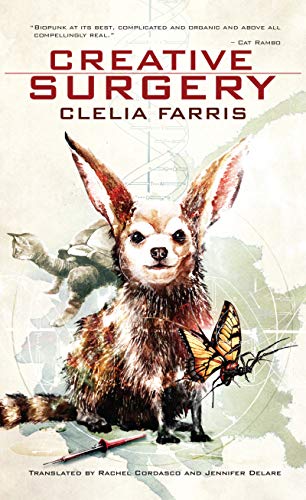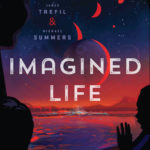I am embarrassed to admit that I started reading Clelia Farris’s brilliant story collection Creative Surgery thinking I was in the middle of a different book. That can happen with Kindle. Everything looks the same. There are no beautiful covers, unique typefaces, pages to turn down. You just open and there is the text. I had lined up several books to read, sampling a little of each one and became engrossed in a story of families in Poland. I put the Kindle aside after checking some of the other books I had promised myself to read by opening them. That did it. I forgot about that last rummaging, and when I opened the Kindle again I wasn’t in Poland anymore.
I was in Sardinia a couple of centuries (?) in the future. A coastal city has been inundated, and people were living in the tops of houses that poked up out of the water. Where was this writer taking me? Here’s an artist character who paddles from one outpost home to another in a boat made of an inverted refrigerator. She has a device, a glass ball, that she uses to paint out memories people want erased. Then another character pops up who makes beautiful forgeries of ancient pottery to fool tomb raiders in another town threatened by an unscrupulous developer. In another story a mirror says it wants to kill the person looking into it every day. What is this?
Little did I know for about half the book that I had landed in the mind of Clelia Farris. Her bizarre characters and settings seem at first impossible, off the wall. But slowly I sank into each of the stories in this amazing collection, translated beautifully by Rachel Cordasco and Jennifer Delare, and gradually fitted myself into their strange reality. Now I’m hoping more of her unique work will soon find its way into English translations.
The first story of the seven collected here is A Day to Remember. Farris comes from Cagliari in Sardinia, a city built on hills, and here she imagines the place inundated by sea-level rise. A series of strange characters survive in hilltop apartments. Most of them seem to live in their dreams and memories. There is a man who believes he is God and preaches to crowds of followers in his mind. There are older people, privileged to take drugs because of their age, who dress up like pirates and attack people paddling from place to place in their makeshift craft. There are young people who see themselves as progressive and want to restore the town council along with municipal services.
And there is Olì, an artist of memory and light, who tries to relieve people of tragic dreams and recollections. She uses a glass bubble to see disturbing memories people have and paint them over with details of scenes from the great masters to make them more beautiful and satisfying. But she is also an artist who can create events like an extraordinary light show with spotlights she had rigged up to form a display she called Dream Time. And in a climactic sequence helps see a close friend off in a spectacular funeral. It may be a world of flotsam and deranged souls, but Olì brings to it a strange beauty that raises deep questions about the reality people choose to assemble around themselves.
From her console she controlled each spotlight from a distance. The beams of colored light lit up according to a musical tempo, at first only three eighth notes on the treble clef and three pink ribbons in the sky, then slowly the sonorous and bright shapes had made entire landscapes appear—woods, mountains, prehistoric towers, hills. A flood of places that were now submerged, accompanied by their own earthy odors. So the lights had taken on the features of forgotten animals—horses, cows, and sheep—hundreds of small white explosions that remained fixed in the sky—accompanied by a shepherd. She had finished with bright Castello designs, their white and square towers, the flag with the Quattro Mori floating above the apparition.
Creative Surgery, Kindle edition, Location 200
The other stories in Creative Surgery are equally inventive and compelling in ways that touch on themes of identity and the literal construction of reality. Many of the characters are artists of one kind or another, and each one plays with ideas of deception and artifice, sometimes to achieve good, sometimes to serve selfish interests, sometimes to follow passions determined by forces that are little understood.
The second story, Gabola, is in some ways the most challenging, switching as it does from first to third person segments, though almost always from the point of view of the title character. He is another artist, his name apparently a play on a word for trash. One of his skills is to make fake reproductions of ancient pottery to fool the thieves who are breaking into the sacred tombs on a hill known as Little Tuva. It turns out this is one strategy Gabola uses to protect the hill from being destroyed, not just by thieves, but by a developer who is determined to smash the ruins of the past and raise new apartment blocks. It turns out that another skill Gabola uses to make money is to sell skills to people, like the ability to learn a language or play a musical instrument, without the usual effort of long training. He does this by having people consume the fresh eggs of sea urchins! (Don’t ask how that works.) And he turns this skill into a complex deception designed to save Little Tuva.
The title story, Creative Surgery, is a novella that is the strangest of all. One of its central characters is Vi, an immensely skillful surgeon who has turned to the grotesque fashion of assembling chimeras out of the body parts of different animals, sometimes including the tissue of human fetuses. The narrator is her helper. He has the ability to weld together the finest components of the little chimeras Vi creates through tiny electrodes in his fingertips. This sounds like it could be pure body horror, but somehow Farris avoids the merely gruesome aspects of this work and focuses on the drive people have to change every aspect of their appearance. Despite the fashion for creating perfect bodies, Vi herself cultivates a different look. The narrator is stunned by the appearance of bags under her eyes:
Good God, those bags! They were like two cobalt-colored beaches on which the turquoise waves of her irises broke. She wasn’t ashamed of them. In fact, she wore them the way other women wear earrings. They formed part of her face on par with her rounded chin and thin lips. Not many people go out nowadays with their own face; nowadays everyone is all sugary, fleshed out, and smoothed off; everyone’s face is a blackboard waiting for the duster.
Creative Surgery, Kindle edition, Location 1669
The art and science of surgery becomes a mania of transformation for its own sake. The narrator is a prime example. He takes the money Vi earns from her strange creations and uses it to inject himself with as many hormones and chemicals as possible to give himself a beautiful appearance. Medical students slobber all over him to get samples they can use to clone.
I bathe in the envy of others, both male and female. They undress me with their eyes. They sniff the air I stir. I am homo novus, imperfect and luminous. I don’t need to abide by the golden mean! My supreme virtue is expressed in a short yet powerful phrase: I am me. How many of you lot, copies of copies, can say the same?
Creative Surgery, Kindle edition, Location 1940
Yet all of this beauty is artificial, and he and Vi become embroiled in a dispute about not only what constitutes genuine physical appearance of the self but also the desires and passions that each of them follow. In the end it can all be undone.
These are powerful stories that bring to mind the worlds of Gibson and Vandermeer and Bruno Schulz but with a unique twist that only Clelia Farris has mastered. The language of this book alone is a marvel, thanks to the brilliant translators as well as the original genius of the author. I’ll keep an eye out for more of her work to appear in English.





Leave a Reply